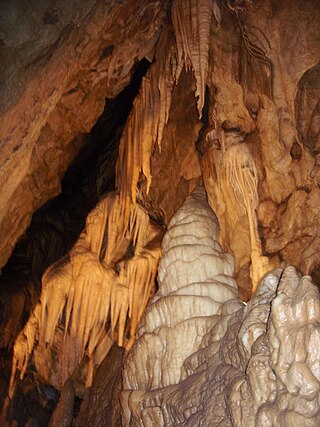Bystrianska jaskyňa
| Bystrianska jaskyňa
|
||
|---|---|---|
| Location: | Bystrá municipality | |
| Height : | 565 m nm | |
|
Geographic location: |
48 ° 50 '25 " N , 19 ° 35' 46" E | |
|
|
||
| Geology: | Gutenstein lime | |
| Discovery: | 1926 | |
| Show cave since: | 1940/1968 | |
| Lighting: | electric | |
| Overall length: | 3531 m | |
| Level difference: | 99 m | |
| Length of the show cave area: |
545 m | |
| Particularities: | Speleotherapy | |
| Website: | http://www.ssj.sk/de/jaskyna/3-die-hohle-von-bystra | |
The Bystrianska jaskyňa (German Bystrá cave ) is located on the southern slope of the Low Tatras in the protection zone of the local national park , south of the municipality of Bystrá ( Okres Brezno ). The entrance to the show cave area is at 565 m nm. The length discovered so far is more than 3.5 km, of which a 545 m long section has been open to tourists since 1968.
The entrance area to the old part of the cave has been known locally for a long time. But it was not until 1923 that J. Kovalčik and E. Laubert went underground. In 1926 the gorge Peklo (German hell) was discovered, via which one arrives at the new part of the cave, the entrance of which was also found in 1932. The cave was opened for the first time in 1939-40, but at that time without electrical lighting. In the final days of the Second World War, an incident occurred here after some residents hid in the cave after the occupation of Bystrá on January 20, 1945 by the Wehrmacht . Although the entrance area was blocked by mines, the inhabitants survived for 21 days at a depth of 40 m until the site was liberated. Today a plaque in the Zrútený dóm reminds of one of the victims who was shot while trying to escape late.
In 1968, today's show cave area was opened up and the cave was declared a national natural monument. Since 1971, speleotherapy has been carried out away from the show cave area in Liečebný dóm , where diseases of the respiratory system in particular are treated.
Similar to other caves in the area, this one was also created by the water activity of the Bystrianka brook through the Mesozoic limestone of the Middle Triassic, in addition to which the locations of light gray Dolomites alternate. The cave passages are essentially shaped by tectonic disturbances. Occasionally , aragonite can be found in the Peklo Gorge .
The relative humidity is 92 to 98% and the air temperature 5.7 to 6.7 ° C. Eight bat species are known, the most common of which are the lesser horseshoe bat ( Rhinolophus hipposideros ) and the mouse- eared bat ( Myotis myotis ).
Web links
- Information from the Slovak cave administration in German
- Entry on mineraly.sk (Slovak)
- Entry on sopsr.sk (Slovak, English)

